How Do I ~ Chase A Break?
At some point or other
during your racing/sportive career, you're going to have to chase a
break down. Because someone, it's never you, has let a wheel go
and a break's gone up the road.
Read on to see how simple it is to explain how to bring a gap back. The execution of said instructions (other than climbing Mont Ventoux five times in 24 hours) is probably one of the hardest things you'll do on a bike. With that in mind, where do we start...
Pay Attention
Prevention is infinitely better than cure. Rule number one of closing gaps is, don't let a gap open in the first
place! If you want to be a player in the race you must always stay
near the front.
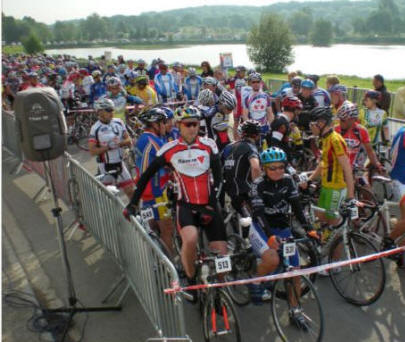
It's hard to say how near the front because it's obviously different for a local event with 30 or 40 riders than it would be for something like the Etape! But you'll soon get the hang of it, or at least you'll soon know if you haven't. Just work your way as far forward as you can while making sure not to stray out of your "anaerobic comfort zone".
And pay attention from the start! I'm sure he won't be too upset if I relay this anecdote; local strongman Chris Stephens was almost dropped in the neutralised section of his first sportive, the mighty Lapabie. He took a drink, looked down to put his bottle back in the cage and a five metre gap had opened. Chasing down a peloton moving at 30 mph, before you've hit the first mountain (which was the Porte de Bales!), isn't the best warm up for a 180k, five mountain, grand sportive!
React Before You Think
One of the things I brought with me, from
motor racing to cycle racing, is the ability to not think (some would
say inability
to think) about what I'm doing. Your actions, reactions and deeds
should be linked to your eyes not your brain. This is especially
useful in descending, particularly on roads you've never seen before.
 Your brain can only slow you down,
so switch
off the negative chatter and bypass the synapse swamp of impending mediocrity.
Your brain is there to protect you. It tells you fibs.
Your brain can only slow you down,
so switch
off the negative chatter and bypass the synapse swamp of impending mediocrity.
Your brain is there to protect you. It tells you fibs.
Ensure your brain is engaged, just switch off the creative and imaginative right hand side and connect your legs to your left hand logic side, your eyes, and ignore everything else.
If an attack goes, there will always be a clue. If a previous break is being brought back, expect an attack. If you're nearing a crest of a rise, expect an attack. If the pace backs off for a fraction, expect...
I'm sure you get the picture by now. In fact here's another pearl of Williams Wisdom. If you're on your bike, and there's more than two of you, EXPECT AN ATTACK!
Open Eyes and Ears...
Someone, hopefully a team mate, will bark a
warning if a rider takes a flyer from mid pack. What normally
happens in this situation is that everyone looks around to see what's
happening, just as the rider blazes up the road. Don't be one of
those, thinking, reaction-dulled, break missing, sheep.
If you hear anything that sounds like a gear change, the rip of a tub screaming against the tarmac or the complaining whip-crack of Zipps being wound up to warp factor sprint; get your backside out the saddle and up the road. When you're up the road in the break you can have a look round. If you have to think about it it's too late and there's nothing to look round at; the race is up the road. Always has been, always will be.
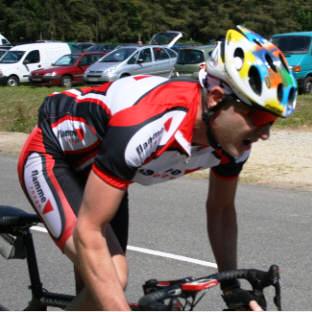
If, after all the kerfuffle, there's nothing afoot, at the very worst you're at the front of the pack and in pole position.
Go wide, swing over and either wait for someone's reactive attack or slowly sidle backwards in to the melange, without getting yourself boxed in, and take a quick drink.
Because now everyone's awake and those that were previously incapacitated by thinking will have thought it's a good (and unique) idea to attack while no one expects it.
The good thing about this mass misconception is you'll have loads of wheels to follow. Make sure you don't switch off and get caught out with a sucker punch.
Don't Panic!
Okay, lets assume, someone in front of you has let a gap go
at the top of a climb and a break has gone up the road. It's gone,
it's already happened, don't get upset or emotional because emotions
cloud judgement. Now it's time to think.
What's the composition of the break? How far from the finish are we? Who's left behind to mount a chase? Is this a key event or a "training race"? Do the maths (math for our American readers) and make a decision. If it's a training race, fire up the road just to see what happens. If it's a key event, box clever.
Be on the lookout for "intelligent others" weighing up their options. If someone makes a decision quicker than you, make sure you're in their train. Don't still be trying to work it out when the chase goes and you're left with the riders from Team Bewildered.
If you are left behind, you will probably be able to take some consolation by winning the bunch sprint! In the land of the blind, the one eyed man is King.
Check the Break Composition
If it's a small, middle marker group,
on a do or die mission, the
chances are they'll stay out for 10 k or so, fatigue of their own
volition and come back to you and the patient others.
If it's a strong-ish group, you'll not want to let them get more than 50 to 100 metres up the road. If it's a big group, what's the make up of riders. Not all will want to work and that can help you.
Sometimes big groups implode because the less-strong riders want to let the strong take them to the line. The strong, don't want to be "sprinted" at the end so will sit up when they get fed up.
As mentioned earlier, if this is one of your key events, take stock of what's happening and make a decision on when to chase. If it's a "throw-away" use the opportunity to practice your gap closing potential. If you make it, you make it, if you don't at least you'll have gained some experience, knowledge, power numbers and sore legs.
Let's assume you've got all the info you need and you've decided to chase. You need to quickly define a strategy to get them back, and stick to it. Either do it with commitment, or don't do it at all.
A Man with a Plan
Apologies ladies, I couldn't find a rhyme
that worked in the femine.
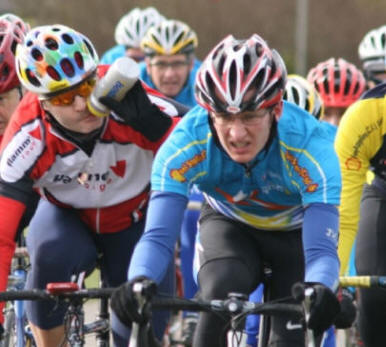
Before you begin your chase, grab a gel, a swig of drink and mentally prepare yourself for a hiding. It's going to hurt, and hurt bad, so switch your pain receptors off and homme or femme up.
Get aero. Get in the drops, keep the shoulders down, keep the head up, get elbows tucked in, sit on the rivet (the nose of the saddle), grab a gear and pedal in circles with a smooth fluid rhythm. If what you're doing isn't making you go faster, stop doing it. You're now in full on time trial mode on a road bike. It's not meant to be fun.
And remember to breath. Deep rhythmic breathing, synched to your pedal cadence. Don't pant, don't snatch at breaths, don't hyperventilate. Don't move around on the bike with shoulders bobbing all over the show. Don't let anyone in front, or behind, see that you're suffering.
For small gaps, of up to 50 metres or so, you might just be able to "sprint across". Bide your time, wait for the wind to change in your favour (don't sprint in to a block headwind) and commit to closing the gap. Try to take someone with you, but obviously not someone who's a better sprinter than you! Don't want to get to the end and come second do we?
If it's a gap of a couple of hundred metres, and there's 50 kilometres to go, then obviously you don't need to get across the gap in the next three minutes. The more energy you spend closing the gap the less you'll have at the finish. However, the longer you're in no-mans land the more energy you'll burn. I never said it would be easy.
Use the road gradients, corner cutting, hedge hiding, any traffic you can draft and all the above body language tricks to make your very difficult task as easy as possible.
Stacking the Numbers
Please take this section in the spirit of it's intention. It's here just to give you some added info, it's not something you
should be working out in the middle of a race. I'm an engineer at
heart and just can't help using maths to solve problems!
This information could change your racing career forever. Once you understand the dynamic relationships between speed, power and time, it all becomes crystal clear. The hard bit is in delivering the goods. Understanding is one thing, doing is another.
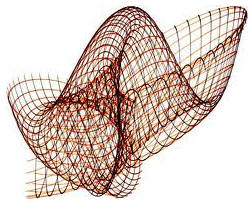 Let's assume that the group ahead of you are
a hundred meters up the road, consolidating their effort, riding at 43 kph.
They travel at 716 metres a minute.
Let's assume that the group ahead of you are
a hundred meters up the road, consolidating their effort, riding at 43 kph.
They travel at 716 metres a minute.
If you ride at 44 kph, you travel at 733 metres a minute. You are pulling them back at 17 metres a minute. One hundred (the gap) divided by seventeen (the closing speed) means it will take six minutes to bring them back.
If you ride at 45 kph, (closing the gap at 33 metres per minute) it will take three minutes. Riding at 46 kph, two minutes and riding at 49 kph takes just one minute, as you cover 816 metres per minute to their 716. So as you can see, the maths is quite simple.
Or is it? Power output is exponential to speed. Which means you have to generate significantly more power to ride at 45 kph than you do at 44kph. It's all to do with drag factors and not for this factsheet; but trust me, riding just one kph faster requires more than you would expect from the rider.
So if our group up the road are riding at X watts to sustain 43kph, you will need to knock out 30 watts more to do 44 kph. To ride at 45 kph you will need around 80 watts more, which is another 50 watts on top of the 30 you've been pushing out.
To go another one kph faster, will require another 80 watts so now you're in to an almost 50% power increase for a 10% speed increase. It's the law of diminishing returns. (See the end of this factsheet for a real-life power trace of this theory in action.)
Rule number two of chasing breaks; Stay under your threshold wattage at all times. Ease up to them in the shortest time you can without sacrificing your end game. Use your knowledge of the numbers to maximise your success.
Power Meter?
If you have a power meter then you've
removed one of the biggest variables you have and can now make informed
decisions on what to do, when and for how long. Here's how...
If you've been using one of our training plans as part of your season preparation then you'll know exactly what your power limits are for all the important time sectors.
If you have to leave the main group to bridge the gap alone, here's how you can do it. Leave your cohorts behind by giving it your full-on, ten second sprinting wattage for just five seconds. This stops people jumping on your wheel and also prevents you from going in to oxygen debt and being reeled back in to the bunch after fourteen seconds.
Depending on how far they're up the road, you use 95% of your 6 minute or 20 minute wattage to bridge the gap. If you're riding in to a headwind, uphill, a false flat or with the wind at your back, you don't go over your wattage limits. The number remains the same.
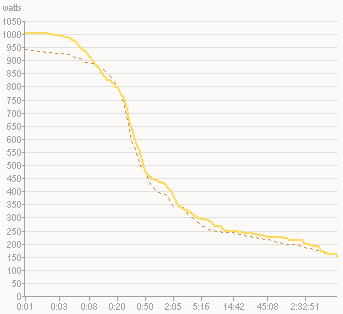
Here's an example of a WKO+ Chart
of sustainable power against time
Solid line is season power, dotted line is power in last 28 days
If you chase and you can't bring them back at least you know you tried as hard as you could. If you ride over your threshold, you'll almost certainly fail and just fuel your self-limiting prejudices that you're not strong enough to bring back a break. You are, you're just doing it wrong!
So, if your "fresh" 20 minute power output
is 300 watts, you chase a long distance break at 285 watts. If
you've not caught them in twenty or so minutes then at least you knew
you did your best.
Getting Help
As with most things in life, many hands make
light work. Well to some extent that's true, but they have to be
the right hands. If the pace ahead is hot, there will be riders
being shelled out the back.
If they were up to it, they wouldn't be coming backwards. But they might be able to share a turn or two with you before they peel off. Recruit them, make them feel wanted, tell them they can get back on if they work with you. They can't, but they don't know that yet.
Never go past anyone from the break without getting them to at least try to get you up there. Even if you just sit behind them for ten seconds to get a breather.
 If
you're bridging a big gap over a period of time you may be sitting ahead
of, and in sight of, the main bunch. At some point someone may attempt
to use you as a bridge to the break. Don't wait for them.
If
you're bridging a big gap over a period of time you may be sitting ahead
of, and in sight of, the main bunch. At some point someone may attempt
to use you as a bridge to the break. Don't wait for them.
If you catch a glimpse of someone coming up to you, keep your steady pace and make sure they have to work to get across to you.
Don't keep turning around to see where they are; subtly drop your head to look between your legs.
If they get within 20 metres or so, make a drama out of sitting up for them. They'll then be less inclined to attack you.
Let them get your wheel, take a drink, take a ten second breather, then get them working. You control the pace, keep talking and don't let them seize the initiative. Even if your dying on your arras, don't let them see it.
Work together, lift the speed slightly and get the gap closed. Never give up. It only takes a hint of indecision, a wind change, or a spat up front over who should pull and they'll come haring back to you. Never give up. Once you're started it's a one-way-trip.
The Catch
Because we're positive thinkers and players,
not the played, we're now just off the back of the group that's lined
out in front of us.
If you're in hilly country, try to time your catch of the group to be at the base of a climb. That way, the group has probably eased off but no one wants to go to the front. It's more than likely lined out and you get bridges from the weaker riders. If you make it to the top, on the back, then you get dragged back in to the group as it reforms on the crest.
I've seen riders in sportives chase like mad men to catch a group in a valley before the bottom of a climb only to be shelled out on the early slopes. They're legs are all lactated up (somehow that reads all wrong!) and they're in full-on oxygen debt. Then someone at the front attacks on the climb and it's game over.
When the catch is made you must ensure that your first objective is the front third of the break, not the back. If you're with the strugglers at the back, come the next acceleration or attack you may not be in a position to respond. If a straggler lets a wheel go you're back in to the same situation all over again. Not good.
Get on the back, get shelter and get on the inside of the group. Ride as quickly and efficiently as you can, moving to the front. If you hit another climb before you're fully recovered at least you've got wheels to follow as you slide backwards. Just remember to move up again.
Once settled, get a gel down your throat and
try to hide until the end game begins. Because that my dear
friends, is a factsheet for another day...
The Message
There are three types of people in this
world...
▼ Those that let things happen
▼ Those that makes things happen and
▼ Those that say "What happened?"
I hope the above message needs no further clarification.
The message is, you can't sprint a 100 metre gap, so don't try. Use everything at your disposal, tactics, terrain and quickly formed alliances to help you close a gap.
Do the numbers, stay calm, be patient and don't be afraid to abandon freeloaders if you think they're not contributing to the chase. No free rides, unless you know they can't sprint.
Cycling is one of the cruelest and most brutal of sports. You're either applying or taking pressure. Sometimes you have no choice as to which end of the stick you're holding. Just make sure you're not holding it for very long and pass it on as quickly as you can. Get your retaliation in first!
To see how much power you need to apply to the pedals when you jump from someone's wheel, and shelter, in to the wind, and go just one mile an hour faster, click here... It really is scary science.
Until next time...








